Southeastern Arizona is an ecological dreamland. I don’t know how I’ve managed to live in North America for 39 years without visiting this incredible region that is at the intersection of Mexico’s Sierra Madre, the Rocky Mountains, and the Sonoran and Chihuahuan deserts. In this region, the Santa Rita Mountains, the Huachucas, and the Chiricahuas, rise abruptly and dramatically from the surrounding arid deserts. They constitute one of the world’s twenty Sky Island complexes, harboring an extraordinary amount of habitat and species diversity and forming ecological stepping stones to the tropics.
Carly, Samantha, and I began our adventure at Madera Canyon, on the northwestern face of the Santa Rita Mountains. We arrived in time to set up camp at Bog Springs Campground, and begin to explore the trails that run adjacent to Madera Creek. After hours of driving through the desert, we were quickly surrounding by large Oaks and Junipers, lofty mountain peaks, and a flowing stream. We were greeted by a Canyon Towhee, a noisy and feisty Bridled Titmouse (referred to as the Samurai Titmouse for the duration of the trip), some marauding Mexican Jays, and this lovely Hermit Thrush, one of the sweetest I’ve seen!
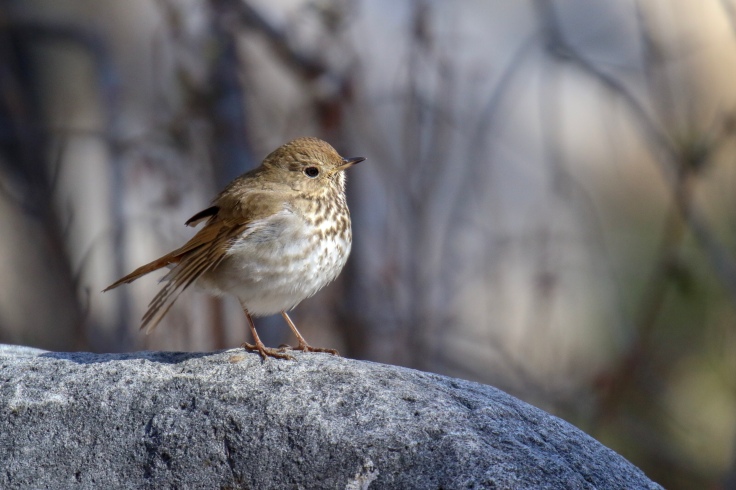
Madera Canyon is considered one of North America’s best birding destination, and we woke up the next morning ready to explore and find some new birds! We were in luck…within the first 30 minutes of our trail walk, we spotted the most quintessential bird of this region…the Elegant Trogon (well, actually, we spotted birders who had spotted this bird, then we saw the bird!). Elegant Trogons are permanent residents throughout the majority of their Mexican and Central American range, but a small number migrate to Arizona, just barely popping over the Arizona border from Mexico. They certainly are striking birds with a metallic green neck that surrounds a bluish face and a white collar that defines the border of a richly red breast and belly. It’s long, square-tipped tail is mostly white with an interesting black barring pattern, a feature we could appreciate as the bird perched facing us.

We encountered this Elegant Trogon a bit later in the morning, further down the creek. They are a tad sluggish, and so are cooperative photo subjects! Their sluggishness is intentional – they will perch motionless, making barely perceptible head movements, as they stalk their insect prey. “Trogon” is the Greek word for “gnawer”, which refers to their insectivore diet and hooked bill.

In the early evening, we made a stop at the feeders at Santa Rita Lodge. This was quite an experience! The lodge has set up a comfortable viewing area set up in front of their many bird feeders. Admittedly, we were a bit skeptical about the “feeder experience”, but the excitement and fascination quickly won us over. Upon arrival, we quickly spotted some “lifer” hummingbird species, including this bold and feisty Broad-billed Hummingbird who was going toe-to-toe with a Lesser Goldfinch. We also saw Black-chinned Hummingbird, Anna’s Hummingbird, and the large and flashy Rivoli’s Hummingbird.

I was quite excited to discover that our abundant Dark-eyed Juncos are not North America’s only juncos! This fierce looking Yellow-eyed Junco ranges from southeastern Arizona through to the mountains of Mexico and Guatemala. In Veracruz, Mexico, in the 1860s, Ornithologist Francis Sumichrist reported that the locals believed that Yellow-eyed Juncos were phosphorescent, collecting light during the day and releasing it at night. The locals called this bird “echa-lumbre”, meaning the caster of fire, or lightning bird. Although we first encountered this striking bird at the feeders, we continued to see it throughout the remainder of the trip, including at Rustler Park in the Chiricahuas.


Birds and birders are not the only ones that have caught on to this world-famous feeding station. Just as we were preparing to leave, a family of Coatimundis slowly arrived…one-by-one, making their way over the fence, ready to raid the feeders. The White-nosed Coatimundi is the only species of this raccoon relative found in the US, but they are much more common in Central and South America. In Arizona, they can be found in pine-oak woodlands or sycamore-studded canyons at higher elevations. Look at that upturned snout! Coatimundis use this long snout, with its flexible nose, to root through the solid for invertebrates or to flip over rocks in search of lizards. They also possess excellent climbing skills and will forage tree canopies for nuts, berries, or even bird eggs!


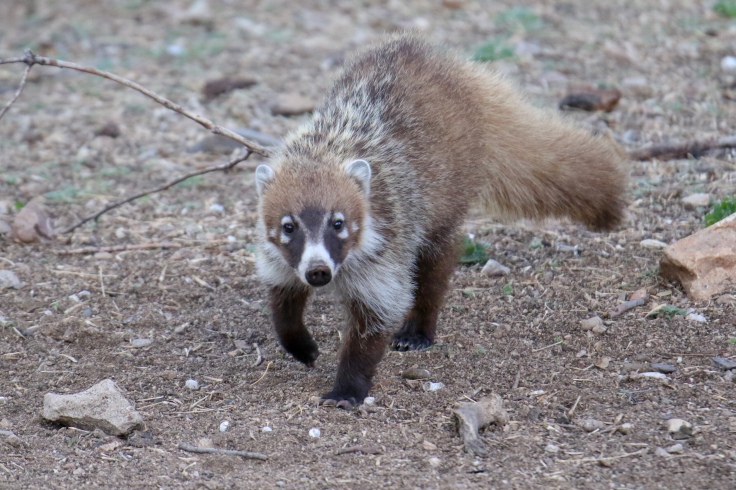
Up next: a day-trip to Patagonia Lakes State Park. I have looked forward to visiting this famous birder destination ever since I saw it highlighted “The Big Year” movie. We headed first to the visitor center, spotting a Vermilion Flycatcher and a pair of feisty Gila Woodpeckers along the way. Near to the lake shore, a Neotropic Cormorant perched on a branch sticking out from the water while Pyrrhuloxia, White-winged Doves, Verdin, and Orange-crowned Warblers flitted around the feeders.
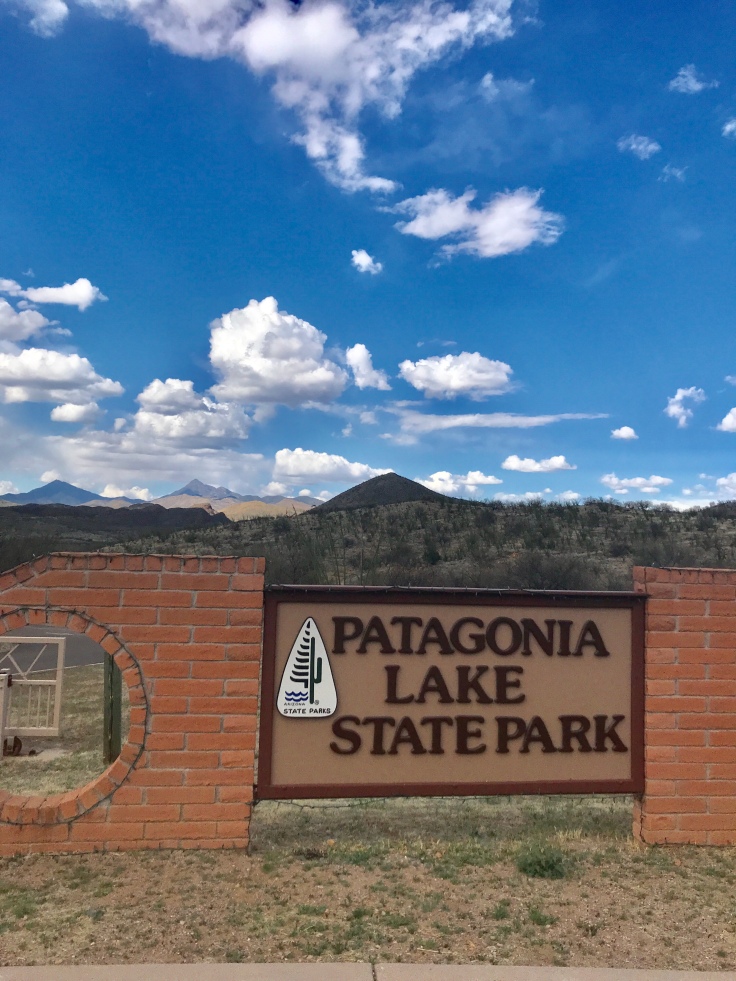 Before getting back into the car to head over to the birding trail, Samantha spotted our first Common Black Hawk soaring overhead. The Birding Trail meandered around the lake, dipping in through riparian woodlands along the way. At early afternoon, it was overcast and a bit chilly, so the bird activity was less than we hoped for. But, a lovely walk, nonetheless. Cinnamon Teal, Green-winged Teal, Pied-billed Grebe, Ruddy Duck, Great Egret, Great Blue Heron on the lake and Common Yellowthroat, Red-winged Blackbird and Marsh Wren in the surrounding reeds. Among the willows, we watched a male Arizona Woodpecker working some bark and a pair of Vermilion Flycatchers covering some ground.
Before getting back into the car to head over to the birding trail, Samantha spotted our first Common Black Hawk soaring overhead. The Birding Trail meandered around the lake, dipping in through riparian woodlands along the way. At early afternoon, it was overcast and a bit chilly, so the bird activity was less than we hoped for. But, a lovely walk, nonetheless. Cinnamon Teal, Green-winged Teal, Pied-billed Grebe, Ruddy Duck, Great Egret, Great Blue Heron on the lake and Common Yellowthroat, Red-winged Blackbird and Marsh Wren in the surrounding reeds. Among the willows, we watched a male Arizona Woodpecker working some bark and a pair of Vermilion Flycatchers covering some ground.
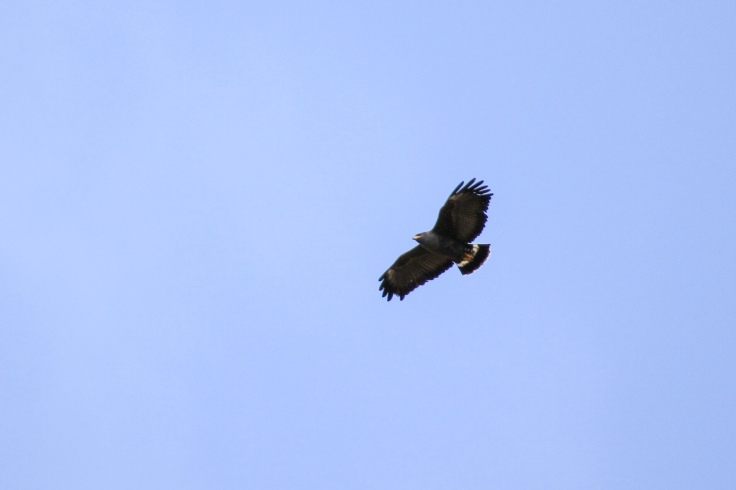
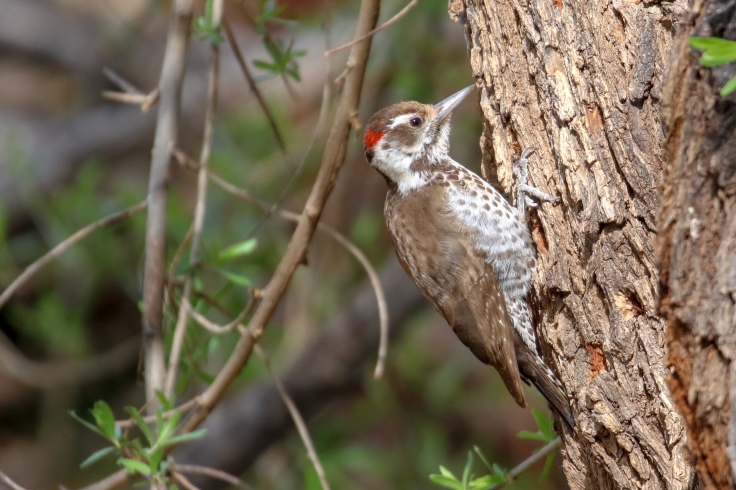
Our exciting feeder experience at the Santa Rita Lodge motivated us to check out The Nature Conservancy’s Paton Center for Hummingbirds in Patagonia, AZ. This 1.4-acre wildlife haven was once home to Marion and Wally Paton, whose feeders became magnets for a variety of resident and migratory birds, most notably: the Violet-crowned Hummingbird, an uncommon species to find in the U.S. The Paton’s were welcoming to the hoards of birders that would line their fence hoping to catch a glance of this hummingbird, or some of the other 200 bird species that have been documented on this property. They encouraged visitors by providing benches, field guides, and a board for recording sightings. Their efforts created an international birding destination. After their death, the Tucson Audubon Society and Nature Conservancy intervened to protect this unique habitat and maintain its accessibility to the public. In 2017, the center attracted 14,000 visitors from 20 countries.

For us, this destination lived up to its reputation. We quickly spotted a Violet-crowned Hummingbird upon arrival, although this bird was outnumbered by the many Broad-billed Hummingbirds buzzing around. The trees on the front of the property hosted both Gila and Ladder-backed Woodpeckers and we were pleasantly surprised to watch a Curve-billed Thrasher pop-out from one of the brush piles. As we left, we watched a large kettle of Turkey Vultures coming in to roost in the riparian woodland adjacent to the property.


We made our way back to the Bog Springs Campground, for our last night in Madera Canyon, and fell asleep to the Morse-code call of a Whiskered-Screech Owl. After some final early morning birding along the creek (and a lovely pair of Hepatic Tanagers!), we departed with the Chiricahua Mountains on our mind, but with plans to first explore the Huachuca Mountains along the way. We were disappointed to discover, upon arrival, that the Ramsey Canyon Preserve is closed Tuesday and Wednesday. It turns out, this was a fortunate mishap as it redirected us to explore Carr Canyon. We made our way up a steep and windy road through Carr Canyon and arrived at the Reef Townsite Campground to find a group of birders chasing a Buff-breasted Flycatcher. Shortly after spotting this lovely bird, we watched an Olive Warbler, then Grace’s Warbler foraging high in the canopy of pines. We made our way to the lower part of the campground, to a grassy clearing between junipers, were a Tufted Flycatcher had been reported. What a treat! We quickly spotted this charming, colorful, crested flycatcher moving between trees. Tufted Flycatchers inhabits woodlands from NW Mexico to Panama, and in South America to Ecuador. This is a rare bird to encounter in North America (ABA Code 4, I believe) and, apparently, only the 6th or 7th record for AZ.
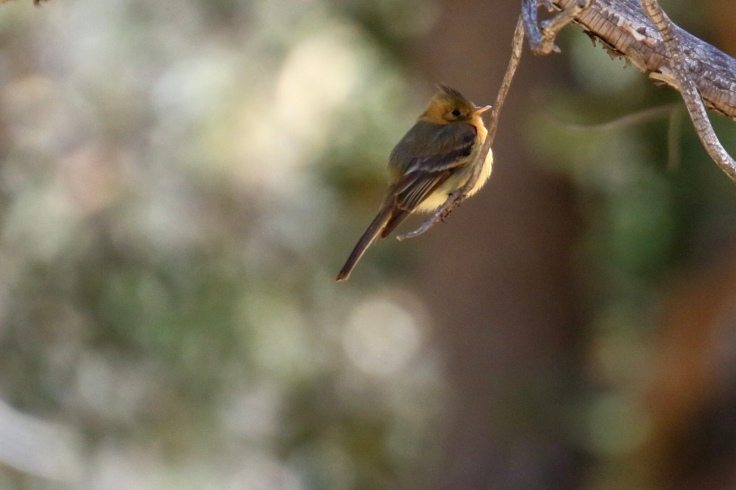

You’d think we’d have had our fill of excitement for the day, but no. A friendly photographer gave us very specific directions to the day roost of a pair of Mexican Spotted Owls. We made our way to an adjacent canyon and hiked in to the area he described, it took awhile of roaming around and looking up, but we finally spotted (ha!) this owl sleeping in a pine right off of the trail. Spotted Owls are classified as three subspecies. The most famous, the Northern Spotted Owl, has long been the focus of a debate over old-growth logging in Northern California and the Pacific Northwest, and over management of its competitor, the Barred Owl. Spotted Owls require mature forests and are particularly sensitive to habitat disruption; the California subspecies is associated with old-growth, complex, unlogged conifer forests and oak woodlands and the Mexican subspecies occurs in pine-oak or mixed conifer forests, often in steep canyons.
The Mexican Spotted Owl can be found from Utah and Colorado and southward into Mexico and has paler plumage and larger white spots than its northern counterparts. Spotted Owls hunt from a perch and mostly in the dark, preferring small and medium-sized mammals such as wood rats, mice, and voles. They are swift and agile fliers and will utilize several different foraging sites throughout the night, wrapping things up just before sunrise.
Observing this bird was really a special moment for me. Spotted Owl populations have declined dramatically in the ranges of all three subspecies. Their strong preference for undisturbed, multilayered, old-growth forests makes them particularly vulnerable to habitat modification and destruction. eBird classifies this species as “sensitive”, and so this particular bird’s precise location is hidden from checklist views and is only accessible at a region-level output. I snapped quite a few shots, and it was hard to leave, but we left this owl in peace to get as much sleep as it could before the night’s hunting begins.


 We celebrated our exciting day with a toast as we explored the San Pedro RNCA and, although we dipped on the target Green Kingfisher, this is a spot definitely worth exploring more!
We celebrated our exciting day with a toast as we explored the San Pedro RNCA and, although we dipped on the target Green Kingfisher, this is a spot definitely worth exploring more!

The largest of the “sky islands, the Chiricahua Mountains are also the most spectacular and are home to species of plants and animals found nowhere else in the U.S. In fact, Cave Creek Canyon is one of Conservation International’s 34 Global Biodiversity Hotspots. As we left the gateway town of Portal, headed for Cave Creek Canyon, grasses quickly gave way to desert scrub, followed by evergreen oaks and Arizona Sycamores. We grabbed the last free spot at Sunny Flat Campground and set up camp while Mexican Jays flocked through, a Ruby-crowned Kinglet bounced around, a Painted Redstart flashed his tail, a Hermit Thrush popped in and out of the brush, and my 800th life bird, a Blue-throated Hummingbird, zipped around. We went for a short hike along the perennial Cave Creek and enjoyed the magnificent scenery, dramatic stone spires and columns abruptly rising up and out of the forest.

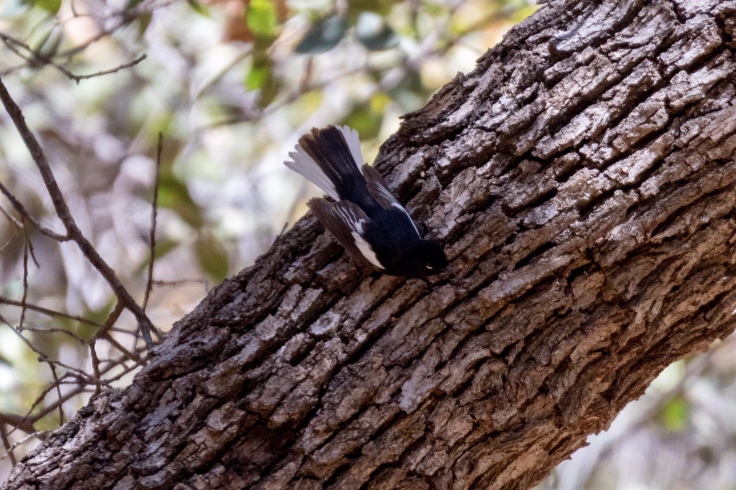


On our last day, we walked through firs and pines and meadows at higher elevations in Rustler Park and Barfoot Park and were in the company of Hairy Woodpeckers, Steller’s Jays, White-breasted Nuthatches, Pygmy Nuthatches, and some fantastic Golden-crowned Kinglets flocking with the more familiar Ruby-crowned Kinglets. We may have dipped on Mexican Chickadees, but Carly made up for it by spotting a Northern Pygmy-Owl that had just caught a meal – a tree lizard from what I can tell. I managed a few photos from a distance, before he flew off. Don’t let his 7″ frame fool you…this tiny bird is ferocious! These diurnal owls actively feed during the day, preferring small songbirds and able to take prey up to three times their own size. We were able to get a nice look at this owls false eyes – a pair of spots on the back of their neck that look like eyes and help to fool attackers or mobbing birds into thinking they are being closely watched!
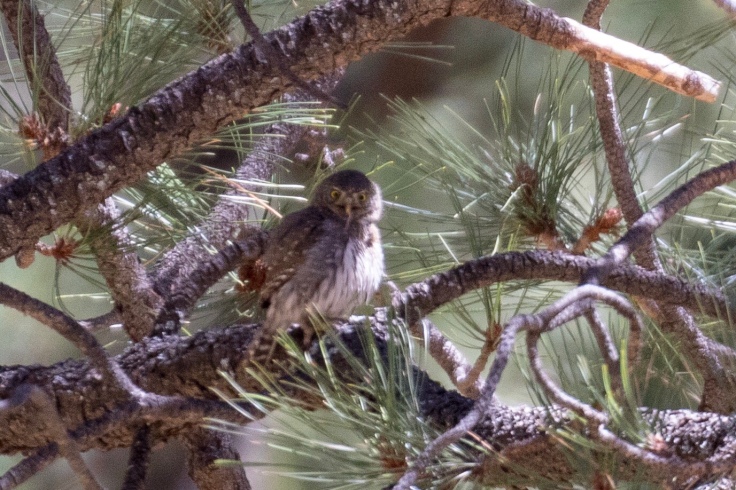
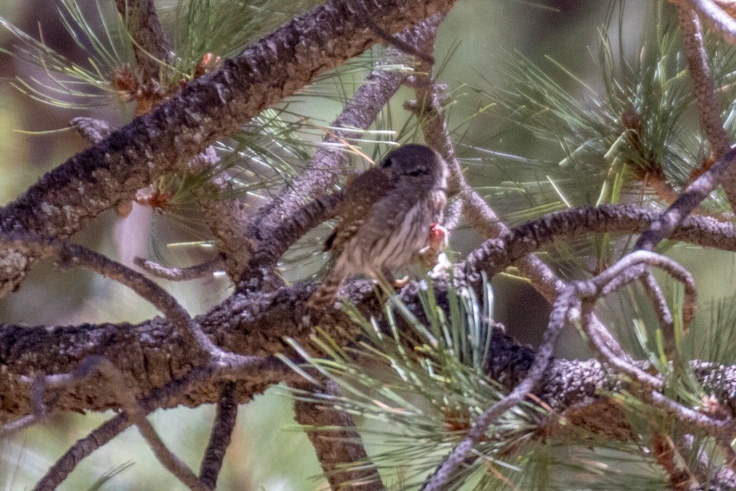
Our final adventure was one of the most fun! I had mentioned to a fellow camper that we were hoping to see Montezuma Quail and he wished us luck, we’d need it. Montezuma Quail are more likely to spot you, before you spot them, and they hunker down and freeze when detected. But, they will explode into flight from a leaping start if they sense danger is too close – more on that in a moment. We returned to our campsite and confessed our inability to find the quail, and our friendly camper let us know that he had scouted them out (with his pointing dog) earlier, and had left us a marker in the road.

We spread out, wandering through grasses between oaks and junipers, hoping to catch a look at the harlequin faces of these short-tailed, round-bodied, small-headed quail. It was quiet, and we neither saw nor heard any signs of quail. Carly announced that she needed a pee break, and so Samantha and I continued on. Well, the quail sensed danger, alright! As it turns out, ~4 Montezuma Quail were crouched down a mere 5′ from where Carly also crouched down!!! From a distance, Samantha and I simultaneously heard Carly screaming in surprise and the loud wingbeats of the leaping and flying quail. I wasn’t able to catch any photos, but we were able to refind them with some effort (and, believe it or not, some more pee!). A fitting end to a fabulous adventure with some fantastic women!







This makes me so happy! Cannot wait for our next adventure!!! The Samurai Titmouse, the best. 💓
LikeLiked by 1 person
I had no idea that there were such brightly colored birds in our state! And I’m so jealous that you saw some cotamundis!
LikeLike
Thanks, Scott! You should definitely check out this area, if you haven’t already. Madera Canyon is super close to Tucson, and there are a few really cute bed and breakfasts. It gave me a new appreciation for Arizona 🙂
LikeLike
Beautiful pictures 🙂
LikeLike
Thank you!
LikeLiked by 1 person
Wow, much owl and hummingbird envy.
Looks like an awesome trip, and congrats on #800! 🙂
LikeLike
Thank you!!
LikeLike
Fantastic adventure! Love the way you write, well done!
LikeLiked by 1 person
Aww thanks Adrienne! The only thing that would’ve made the trip better is if you were there! Next time!!
LikeLike
Great post! I’ve never been birding in America, just Europe, Asia and Africa, but this sounds fantastic! The Elegant Trogon is a beauty! Trogons are some of my favourite birds, the last one I saw was na impressive pair of Whitehead’s Trogon, endemic to Borneo. Feel free to read my trip report: https://myzoneisbirding.wordpress.com/2018/07/30/birding-tour-sabah-borneo
LikeLike